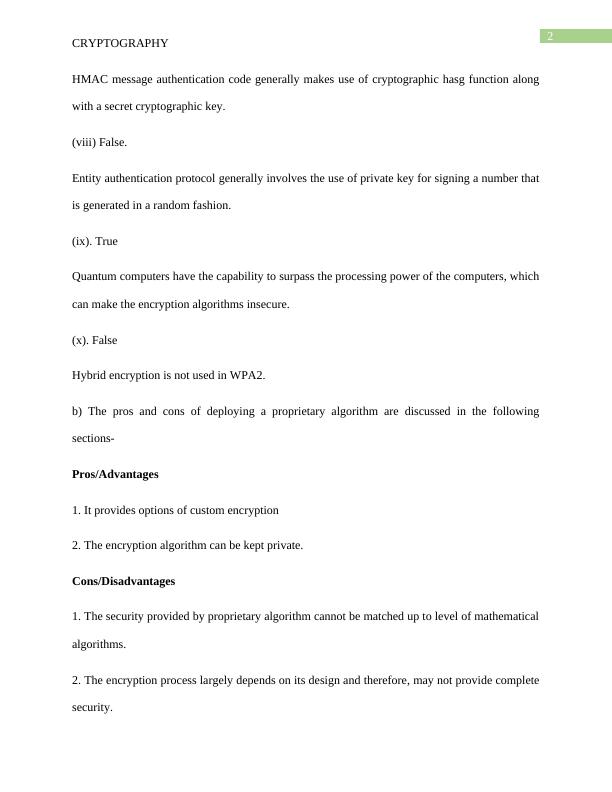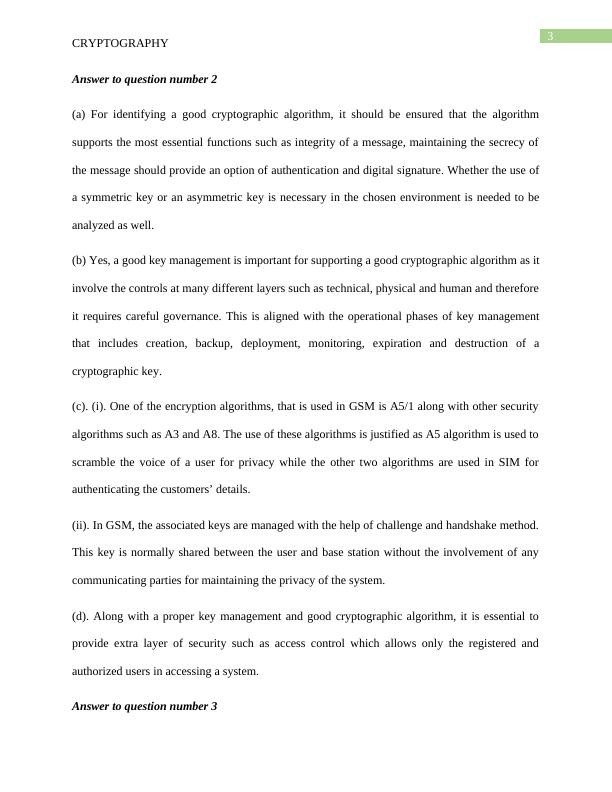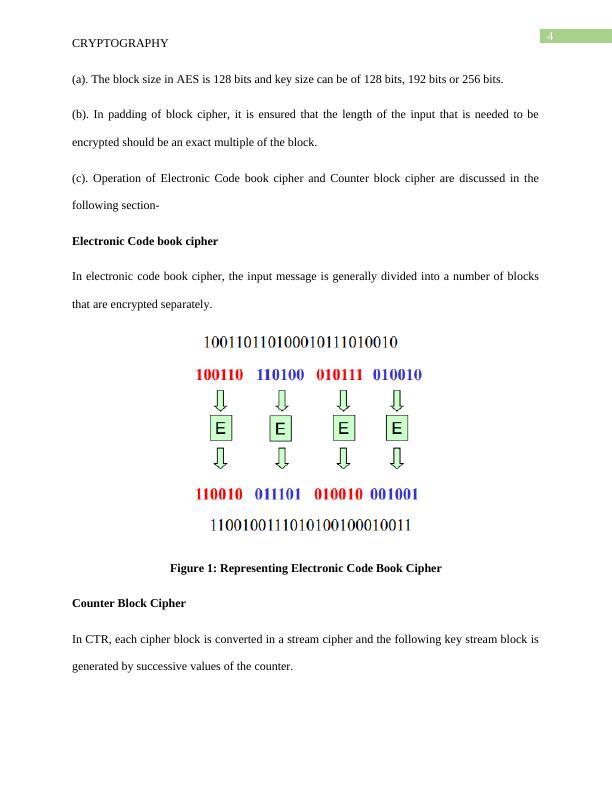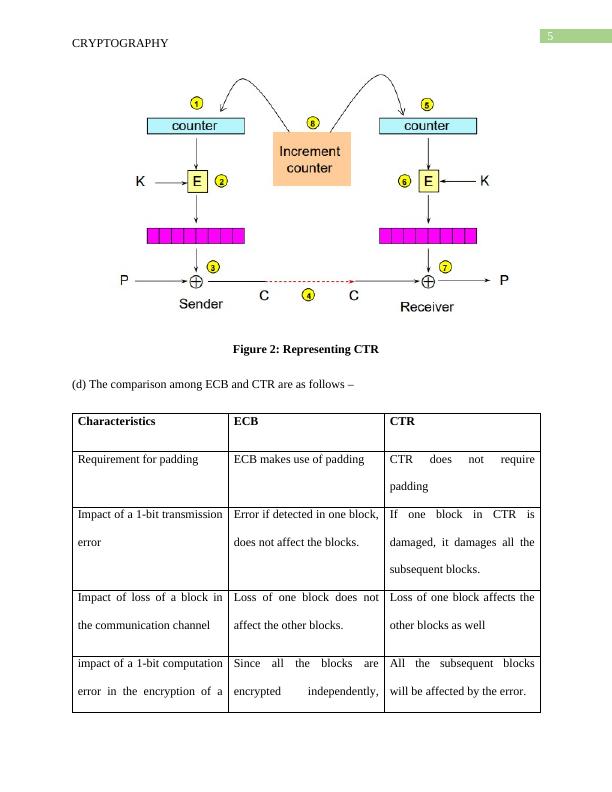Cryptography: Algorithms, Key Management, and Protocols
Added on 2023-06-12
30 Pages7402 Words319 Views
Running head: CRYPTOGRAPHY
Cryptography
Name of the Student:
Name of the University:
Author Note
Cryptography
Name of the Student:
Name of the University:
Author Note

1
CRYPTOGRAPHY
Year 2013
Answer to Question number 1
(a)
(i). False.
Cryptography is a process that provides the technical means to replicate some of the key security
requirements of the physical world in an electronic environment.
(ii). True.
Encrypted data can be accessed by authorized users, thus it provides data integrity.
(iii). True.
The key sizes used in asymmetric key are of generally 1024, 2048 and 4096 bits.
(iv). True.
Error cannot propagate through stream cipher due to the generation of pseudorandom key stream.
(v). True.
It is used in one-time pad for sending plain text because it is a type of substitution cipher where
the original message is replaced by the corresponding letter after shifting in the alphabet.
(vi). False
In RSA, d= modular multiplicative inverse of e (modulo λ(n))
(vii). True.
CRYPTOGRAPHY
Year 2013
Answer to Question number 1
(a)
(i). False.
Cryptography is a process that provides the technical means to replicate some of the key security
requirements of the physical world in an electronic environment.
(ii). True.
Encrypted data can be accessed by authorized users, thus it provides data integrity.
(iii). True.
The key sizes used in asymmetric key are of generally 1024, 2048 and 4096 bits.
(iv). True.
Error cannot propagate through stream cipher due to the generation of pseudorandom key stream.
(v). True.
It is used in one-time pad for sending plain text because it is a type of substitution cipher where
the original message is replaced by the corresponding letter after shifting in the alphabet.
(vi). False
In RSA, d= modular multiplicative inverse of e (modulo λ(n))
(vii). True.

2
CRYPTOGRAPHY
HMAC message authentication code generally makes use of cryptographic hasg function along
with a secret cryptographic key.
(viii) False.
Entity authentication protocol generally involves the use of private key for signing a number that
is generated in a random fashion.
(ix). True
Quantum computers have the capability to surpass the processing power of the computers, which
can make the encryption algorithms insecure.
(x). False
Hybrid encryption is not used in WPA2.
b) The pros and cons of deploying a proprietary algorithm are discussed in the following
sections-
Pros/Advantages
1. It provides options of custom encryption
2. The encryption algorithm can be kept private.
Cons/Disadvantages
1. The security provided by proprietary algorithm cannot be matched up to level of mathematical
algorithms.
2. The encryption process largely depends on its design and therefore, may not provide complete
security.
CRYPTOGRAPHY
HMAC message authentication code generally makes use of cryptographic hasg function along
with a secret cryptographic key.
(viii) False.
Entity authentication protocol generally involves the use of private key for signing a number that
is generated in a random fashion.
(ix). True
Quantum computers have the capability to surpass the processing power of the computers, which
can make the encryption algorithms insecure.
(x). False
Hybrid encryption is not used in WPA2.
b) The pros and cons of deploying a proprietary algorithm are discussed in the following
sections-
Pros/Advantages
1. It provides options of custom encryption
2. The encryption algorithm can be kept private.
Cons/Disadvantages
1. The security provided by proprietary algorithm cannot be matched up to level of mathematical
algorithms.
2. The encryption process largely depends on its design and therefore, may not provide complete
security.

3
CRYPTOGRAPHY
Answer to question number 2
(a) For identifying a good cryptographic algorithm, it should be ensured that the algorithm
supports the most essential functions such as integrity of a message, maintaining the secrecy of
the message should provide an option of authentication and digital signature. Whether the use of
a symmetric key or an asymmetric key is necessary in the chosen environment is needed to be
analyzed as well.
(b) Yes, a good key management is important for supporting a good cryptographic algorithm as it
involve the controls at many different layers such as technical, physical and human and therefore
it requires careful governance. This is aligned with the operational phases of key management
that includes creation, backup, deployment, monitoring, expiration and destruction of a
cryptographic key.
(c). (i). One of the encryption algorithms, that is used in GSM is A5/1 along with other security
algorithms such as A3 and A8. The use of these algorithms is justified as A5 algorithm is used to
scramble the voice of a user for privacy while the other two algorithms are used in SIM for
authenticating the customers’ details.
(ii). In GSM, the associated keys are managed with the help of challenge and handshake method.
This key is normally shared between the user and base station without the involvement of any
communicating parties for maintaining the privacy of the system.
(d). Along with a proper key management and good cryptographic algorithm, it is essential to
provide extra layer of security such as access control which allows only the registered and
authorized users in accessing a system.
Answer to question number 3
CRYPTOGRAPHY
Answer to question number 2
(a) For identifying a good cryptographic algorithm, it should be ensured that the algorithm
supports the most essential functions such as integrity of a message, maintaining the secrecy of
the message should provide an option of authentication and digital signature. Whether the use of
a symmetric key or an asymmetric key is necessary in the chosen environment is needed to be
analyzed as well.
(b) Yes, a good key management is important for supporting a good cryptographic algorithm as it
involve the controls at many different layers such as technical, physical and human and therefore
it requires careful governance. This is aligned with the operational phases of key management
that includes creation, backup, deployment, monitoring, expiration and destruction of a
cryptographic key.
(c). (i). One of the encryption algorithms, that is used in GSM is A5/1 along with other security
algorithms such as A3 and A8. The use of these algorithms is justified as A5 algorithm is used to
scramble the voice of a user for privacy while the other two algorithms are used in SIM for
authenticating the customers’ details.
(ii). In GSM, the associated keys are managed with the help of challenge and handshake method.
This key is normally shared between the user and base station without the involvement of any
communicating parties for maintaining the privacy of the system.
(d). Along with a proper key management and good cryptographic algorithm, it is essential to
provide extra layer of security such as access control which allows only the registered and
authorized users in accessing a system.
Answer to question number 3

4
CRYPTOGRAPHY
(a). The block size in AES is 128 bits and key size can be of 128 bits, 192 bits or 256 bits.
(b). In padding of block cipher, it is ensured that the length of the input that is needed to be
encrypted should be an exact multiple of the block.
(c). Operation of Electronic Code book cipher and Counter block cipher are discussed in the
following section-
Electronic Code book cipher
In electronic code book cipher, the input message is generally divided into a number of blocks
that are encrypted separately.
Figure 1: Representing Electronic Code Book Cipher
Counter Block Cipher
In CTR, each cipher block is converted in a stream cipher and the following key stream block is
generated by successive values of the counter.
CRYPTOGRAPHY
(a). The block size in AES is 128 bits and key size can be of 128 bits, 192 bits or 256 bits.
(b). In padding of block cipher, it is ensured that the length of the input that is needed to be
encrypted should be an exact multiple of the block.
(c). Operation of Electronic Code book cipher and Counter block cipher are discussed in the
following section-
Electronic Code book cipher
In electronic code book cipher, the input message is generally divided into a number of blocks
that are encrypted separately.
Figure 1: Representing Electronic Code Book Cipher
Counter Block Cipher
In CTR, each cipher block is converted in a stream cipher and the following key stream block is
generated by successive values of the counter.

5
CRYPTOGRAPHY
Figure 2: Representing CTR
(d) The comparison among ECB and CTR are as follows –
Characteristics ECB CTR
Requirement for padding ECB makes use of padding CTR does not require
padding
Impact of a 1-bit transmission
error
Error if detected in one block,
does not affect the blocks.
If one block in CTR is
damaged, it damages all the
subsequent blocks.
Impact of loss of a block in
the communication channel
Loss of one block does not
affect the other blocks.
Loss of one block affects the
other blocks as well
impact of a 1-bit computation
error in the encryption of a
Since all the blocks are
encrypted independently,
All the subsequent blocks
will be affected by the error.
CRYPTOGRAPHY
Figure 2: Representing CTR
(d) The comparison among ECB and CTR are as follows –
Characteristics ECB CTR
Requirement for padding ECB makes use of padding CTR does not require
padding
Impact of a 1-bit transmission
error
Error if detected in one block,
does not affect the blocks.
If one block in CTR is
damaged, it damages all the
subsequent blocks.
Impact of loss of a block in
the communication channel
Loss of one block does not
affect the other blocks.
Loss of one block affects the
other blocks as well
impact of a 1-bit computation
error in the encryption of a
Since all the blocks are
encrypted independently,
All the subsequent blocks
will be affected by the error.

End of preview
Want to access all the pages? Upload your documents or become a member.
Related Documents
Introduction to Cryptography and Security Mechanismslg...
|33
|5553
|256
Cryptography and Steganography Techniqueslg...
|10
|1022
|100
Principle and Method in Cryptographic Security | Discussionlg...
|4
|638
|19
Symmetric Encryption Assignmentlg...
|5
|884
|175
UML and Cryptographylg...
|12
|3025
|447
Encryption Techniques Assignment 2022lg...
|9
|2287
|7